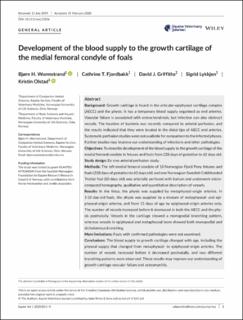| dc.description.abstract | Background: Growth cartilage is found in the articular-epiphyseal cartilage complex (AECC) and the physis. It has a temporary blood supply organised as end arteries. Vascular failure is associated with osteochondrosis, but infection can also obstruct vessels. The location of bacteria was recently compared to arterial perfusion, and the results indicated that they were located in the distal tips of AECC end arteries. Systematic perfusion studies were not available for comparison to the infected physes. Further studies may improve our understanding of infections and other pathologies. Objectives: To describe development of the blood supply to the growth cartilage of the medial femoral condyle in fetuses and foals from 228 days of gestation to 62 days old. Study design: Ex vivo arterial perfusion study. Methods: The left medial femoral condyle of 10 Norwegian Fjord Pony fetuses and foals (228 days of gestation to 62 days old) and one Norwegian-Swedish Coldblooded Trotter foal (10 days old) was arterially perfused with barium and underwent microcomputed tomography, qualitative and quantitative description of vessels. Results: In the fetus, the physis was supplied by metaphyseal-origin arteries. In 1-10 day-old foals, the physis was supplied by a mixture of metaphyseal- and epiphyseal-origin arteries, and from 15 days of age by epiphyseal-origin arteries only. The number of vessels increased before it decreased in both the AECC and the physis postnatally. Vessels in the cartilage showed a monopodial branching pattern, whereas vessels in epiphyseal and metaphyseal bone showed both monopodial and dichotomous branching. Main limitations: Foals with confirmed pathologies were not examined. Conclusions: The blood supply to growth cartilage changed with age, including the physeal supply that changed from metaphyseal- to epiphyseal-origin arteries. The number of vessels increased before it decreased postnatally, and two different branching patterns were observed. These results may improve our understanding of growth cartilage vascular failure and osteomyelitis. | en_US |

